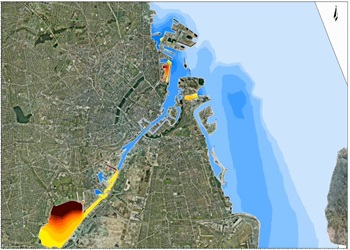Comprehensive monitoring and modelling of discharges of hazardous substances in the Copenhagen Harbour district revealed the most important point sources of selected substances and thereby allows for a sensible and target-oriented prioritisation of future mitigation measures.
The present study determined whether or not specific point sources (e.g. wastewater treatment plants, industries or combined sewer overflow) release significant emissions of hazardous substances as listed in the Baltic Sea Action Plan. It was carried out within the framework of the EU-funded COHIBA-project (Control of Hazardous Substances in the Baltic Sea Region) as a combination of wastewater measurements, load estimations and modelling of the discharges (hydrodynamic marine fate modelling with MIKE 3 and MIKE ECOlab). 
The survey covers discharges from point sources such as urban wastewater treatment plants (UWWTP), sewer overflows (CSO), runoff, landfills and selected industries. After mapping discharges of hazardous substances in Copenhagen Harbour, the transport and fate of these substances was modelled (see the animation at the end of the text).
The study shows that land-based point sources are important for the following substances (major point sources are indicated in parentheses):
- PFC - Perfluorinated compounds (urban runoff, CSO)
- Nonylphenolethoxylates (surface runoff from the industrial area, CSO, UWWTP)
- Bisphenol A (waste incineration plant, UWWTP + bypass)
- Mercury (UWWTP)
The project provides a very useful decision-support tool for the local urban authorities and planners. With the information at hand, measures can now be focused on the relevant point sources of the prioritised substances. Moreover, the methodology can be used in the future to decide whether and where actions targeting point sources are necessary and beneficial.
The study has been financed by the City Of Copenhagen, Copenhagen Energy, Lynettefaellesskabet and The Baltic Sea Region Programme (2007-2013).
About COHIBA
COHIBA (Control of Hazardous Substances in the Baltic Sea Region) is an international project partly financed by the European Union (European Region Development Fund) that aims at identifying the most important sources and quantifying releases of 11 selected hazardous substances into the Baltic Sea. Moreover, COHIBA wants to estimate the impact of these substances on the marine environment and develop cost-effective management options to reduce discharges.
Hydrodynamic fate modelling of Bisphenol A in Copenhagen Harbour. The animation shows the modelled discharge, spreading and fate of Bisphenol A after heavy rain, which results in combined sewer overflows. Moreover, industrial discharges are modelled. The model takes into account substance specific fate data (biodegradation, photolysis and hydrolysis) as well as adsorption to suspended solids.